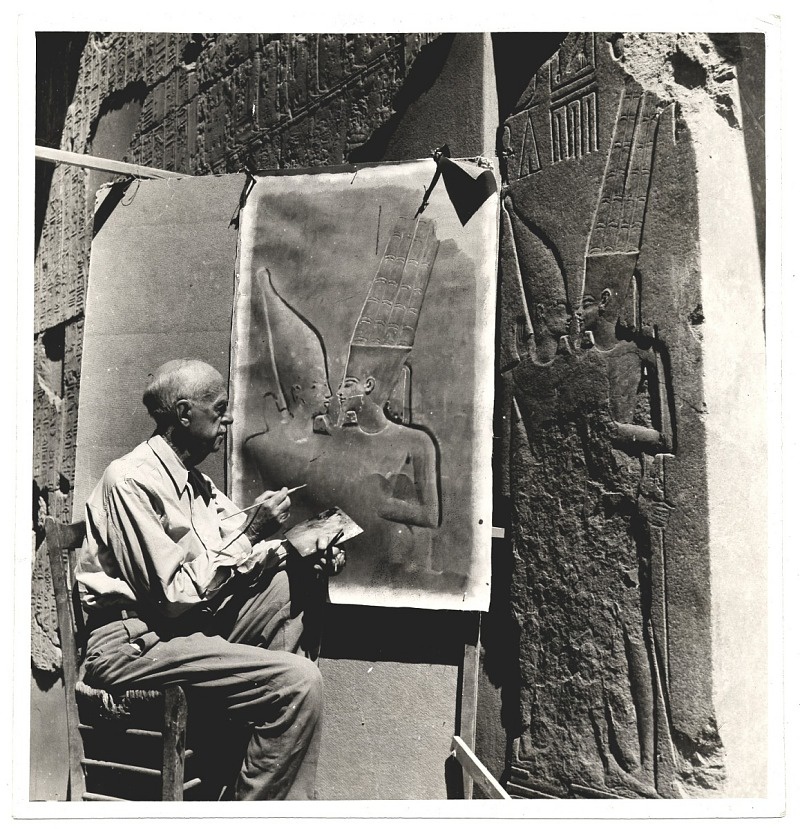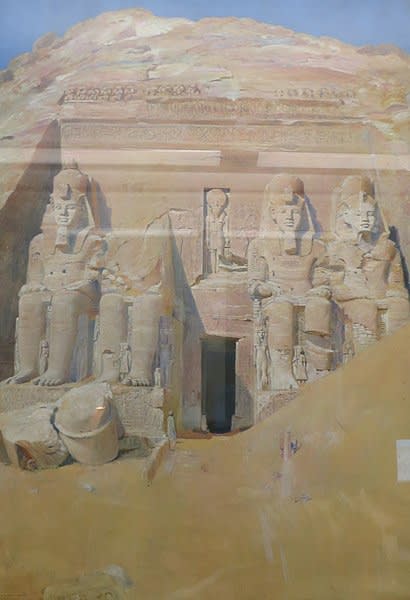Painting Ancient Egypt - Joseph Lindon Smith

AN EGYPTIAN WOOD FIGURE OF A MAN
New Kingdom, 18th Dynasty, circa 1550- 1307 BC
Height: 20.5 cm
Provenance
Joseph Lindon Smith (1863 - 1950), New Hampshire, USA, acquired before 1950
Christie's, New York, 18 December 1996, lot 59
This beautiful Egyptian wood figure in the form of a young man was once in the collection of Joseph Lindon Smith (1863-1950). Lindon Smith is today remembered as one of the most magnificent painters of Egyptian archaeological sites and artefacts.
 Joseph Lindon Smith reproducing an Egyptian bas relief, ca. 1940
Joseph Lindon Smith reproducing an Egyptian bas relief, ca. 1940

Joseph Lindon Smith, Abu Simbel, 1899-1900
Harvard Art Museums/ Fogg Museum, inv.no. 1954.158
Already a successful portrait painter from Boston, Joe had spent many years visiting Greece and Italy honing his talent and growing his reputation for capturing ancient art and architecture with marvellous accuracy. It was on these trips that he began to form a network of patrons, including Isabella Stewart Gardner.
In December 1898, he first travelled to Egypt and gazing upon the sphinx later wrote to his parent:
‘Nothing can be said or written which will give much idea of the feelings and thoughts the first sight of these stupendous things gives rise to. It is impossible to think of their makers as to realize the distance of stars or their sizes. I sat in the hot sand and looked into that battered, mutilated face...and imagined the scene if all who had ever looked at the Sphinx were seated there about me.'

Joseph Lindon Smith, Egyptian Relief - Incised Head, 1900
Harvard Art Museums/Fogg Museum, inv.no. 1926.33.186
Whilst painting the colossi of Ramses II at Abu Simbel, an elderly woman approached him and bought eight of his paintings. That woman was Phoebe Apperson Hearst, the widow of millionaire and senator George Hearst, the mother of William Randolph Hearst. and also patron to archaeologist George Reisner’s famous excavations in Giza. Reisner was struck by the beauty and incredible archaeological accuracy of Joe’s work. With the support of Hearst and Reisner, Joe began a glorious career and a lifelong love of Egypt which he shared with his wife Corinna who has a passion for Islamic culture and scholarship.

Joseph Lindon Smith, Wall relief from Tomb of Sibtah,
Valley of the Kings, Luxor, Egypt, 1905-1916
Rhode Island School of Design Museum, inv.no. 19.213
When Hearst proudly displayed Joe’s paintings to Reisner, he observed that Smith had “accomplished the impossible” by splendidly depicting three-dimensional relief carvings in a two-dimensional painting. Reisner noticed another factor that entranced him as much as it had Hearst: “Each painting was an archaeological record correct in detail, but beautiful as a picture.” In many cases, his paintings are an incredibly important surviving documentation of the colours and details of Egyptian antiquities, whose polychrome did not long survive the change of atmosphere. The work of Joseph Lindon Smith helps us bring Ancient Egypt to life once again.